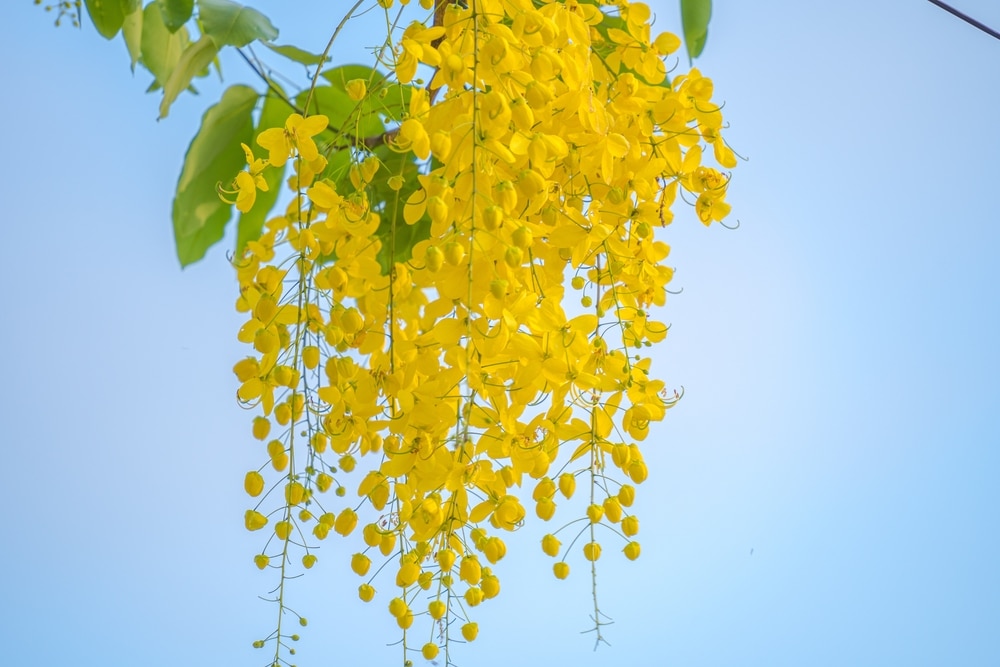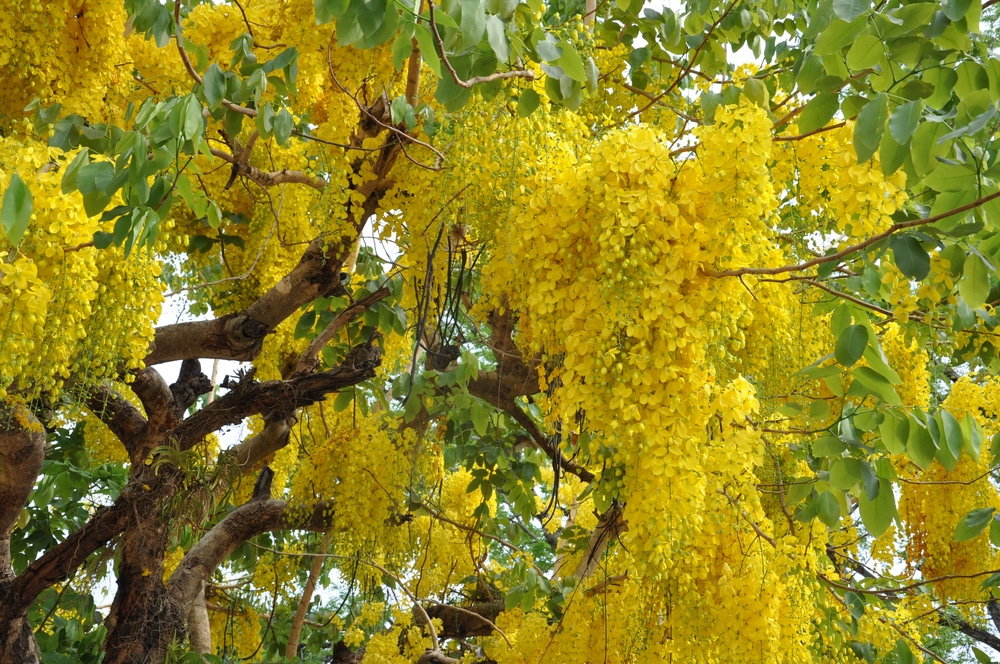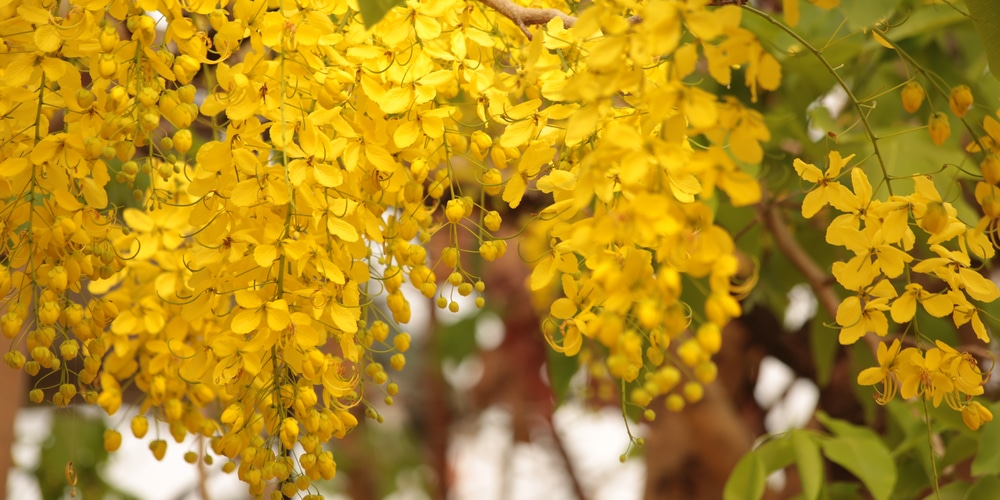The Cassia Tree is a slow-growing forest tree species that produces clusters of hanging yellow flowers.
| Botanical Name | Cassia fistula |
| Common Name | Golden Shower Tree, Cassia Tree |
| Plant Type | Perennial |
| Flower Color | Trellises of bright yellow blooms |
| Size When Mature | 400 to 700 inches |
| Bloom Time | Spring |
| Sun Requirements | Full Sun |
| USDA Hardiness Zones | 9 to 11 |
| Soil PH Range | 5.5 to 8.7 |
| Soil Type | Loamy, sandy and well-draining |
| Water Needs | (High, Low, Medium) |
| Native Area | Southeast Asia |
What you Need to Know About The Cassia Tree
The Cassia Tree encompasses several varieties and in deciduous, semi-evergreen and evergreen aspects. Flowers can be anywhere from red, white, and pink, with yellow being the most common.
It’s often called the Gold Medallion Tree or Golden Shower Tree as the tree tends to put out long chains of golden yellow blooms that hang from the crown and branches.
It’s worth noting that the Cassia Tree is not ideal in a yard or garden with pets or small children. All of its parts, including the flowers, leaves, and fruit are poisonous and toxic when ingested. The tropical tree also has a slow-growing habit but has a high heat and drought tolerance.
Flowers appear in spring and turn into brown pods (fruit) several weeks later.
How to Care for The Cassia Tree
Here’s everything you need to know about growing and caring for a thriving Cassia fistula
Light
The Golden Shower tree belies its somewhat sluggish nature with a strict requirement for a spot that gets full sun throughout the day. When planting a Cassia tree, you’ll want to place it in the sunniest spot in your yard or garden, or else you won’t get the characteristic yellow shower associated with the tree.
The hotter the area and the more sun a Cassia tree gets, the better. Unfortunately, those who live in a shaded location or have a yard that only receives a few hours of direct sunlight will want to look for another specimen. However, once you meet this specific growing requirement then you’ll find the rest to be easy.
Water and Soil Needs
The Cassia fistula species isn’t too particular when it comes to soil pH as long as the medium drains well. The beautiful tree will grow equally in acidic, alkaline, or neutral soil as long as it gets the water it needs to establish a strong root system.
Should you want the best for your Cassia tree, then you should amend your garden soil with aged compost and peat moss. A dose of slow-release fertilizer upon planting will give the tree it needs to get a headstart. When young, make sure to irrigate frequently and keep the soil moist.
Temperature Requirements
Those living in USDA zones 9 to 11 can grow the Cassia tree without any fear of frost. Outside of the recommended climate, the Cassia Tree will show signs of frost damage when the winter season comes. The lowest temperature the tree can tolerate is 30 degrees F, but the Golden Shower tree can grow without a problem in a tropical or subtropical climate.
Fertilizer
The best fertilizer to use on a Cassia Tree is a balanced, general-purpose fertilizer with a 10-10-10 NPK ratio. You can supplement with bone meal to promote blooming when the spring season comes around.
Follow the instructions as directed on the manufacturer’s label. Alternatively, you can also feed with a slow-release granular fertilizer at the start of the growing season. Water the fertilizer so it will get absorbed by the roots.
Fertilizing a tree should be done at the drip line, or where the edge of the canopy lies. You should broadcast the fertilizer around the canopy and not near the trunk for optimal results. Generally speaking, young trees and saplings require more feeding compared to mature and established specimens.
Common Diseases
The Golden Shower tree is usually not bothered by pests or diseases but can suffer from common problems such as root rot, leaf spot, and mildew. Caterpillars can also sometimes invade the Cassia Tree and defoliate it.
Leaf spot and root rot can be avoided by seeing if the soil is dry at the surface before irrigating your Cassia tree. It’s best to avoid watering overhead and getting its leaves constantly wet to avoid fungal diseases and mildew. The moment you see leaf yellowing and slowed growth, stop watering and allow the soil to dry out.
Caterpillars may be picked off on sight, but an infestation may require an insecticidal spray. It’s best to spot these issues early on so you can prevent your cassia tree’s health from deteriorating. Established plants will be more resistant to pests and diseases, so keep a close eye on your cassia tree seedling in the first few months.
Cassia Tree Propagation
You can reproduce several Cassia trees by means of layering, cuttings, or by seed.
Propagating a Golden Shower Tree starts with a ripe seed that you can germinate come the summer season. To start, rinse the seeds to remove the pulp, then do a process of scarification to remove the seed coat.
Plant the seed in a large pot with a sterile mix. The seeds should be sown an inch deep and kept in a bright and warm location. Keep the soil moist and you should see signs of growth in a month or two.


